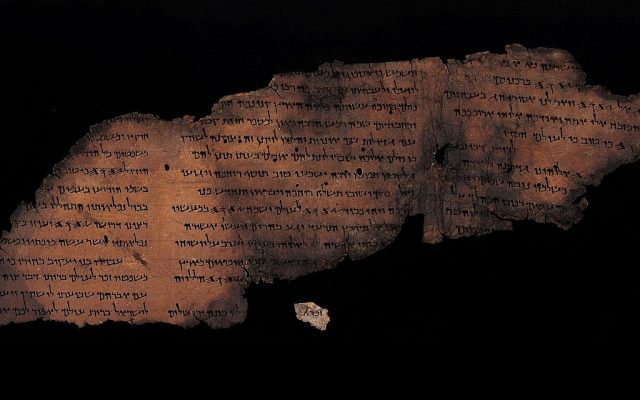
New Dead Sea Scroll Fragment Unveiled in Israel
Previously unseen Dead Sea Scroll fragments, which had been stored in cigar boxes since archaeologists unearthed them in the 1950s, were identified and unveiled at an international conference on Tuesday in honor of the 70th anniversary of the scrolls’ discovery in Jerusalem, the Times of Israel reports.
The tiny fragments, all thought to be taken from Qumran’s Cave 11, are game changers and provide new puzzle pieces towards completing the picture of known published scrolls, experts said.
One of the fragments, unusually written 2,000 years ago in anachronistic First Temple script, may even point to a wholly unique, previously unknown manuscript. “This fragment could not be attributed to any one of the known manuscripts,” the conference organizers said. “This raises the possibility that it belonged to a still unknown manuscript.”
Another fragment turned out to belong to the Temple Scroll, a text dealing with directions for conducting the services in the ideal Temple. “In current scholarship there is a debate if there are two or three copies of the Temple Scroll found in Cave 11 near Qumran,” according to the conference organizers. “The identification of the new fragment strengthens the theory that a manuscript given the number 11Q21 is indeed a third copy of this text from Cave 11.”
Roughly only 1.5 cm x 1 cm in size, the fragments were presented at a day of academic sessions held at the Israel Museum as part of the week-long symposium, “The Dead Sea Scrolls at Seventy: ‘Clear a Path in the Wilderness,” sponsored by the Israel Antiquity Authority, the Hebrew University’s Orion Center for the Study of the Dead Sea Scrolls, the University of Vienna and New York University, and the Israel Museum.
Emblematic of the ongoing innovative scholarship in the field of Dead Sea Scrolls research, the hitherto overlooked fragments, newly researched as part of an IAA pilot project, were identified using the latest technological advances of the Dead Sea Scrolls Unit, headed by Pnina Shor.
One scroll fragment, containing the single Hebrew word, “zamra,” has been tentatively identified as a lost portion of the Great Psalms Scroll, one of the largest and best preserved of the Qumran manuscripts. The word “zamra” appears only once in the Book of Psalms. Another word with the same sequence of letters, “zimra,” is found another three times in the Hebrew Bible.
“The new fragment preserves part of the beginning of Psalm 147:1,” the conference organizers said. “The end of the same verse is preserved in a large fragment that was purchased and originally published by Yigal Yadin. The new fragment indicates that the text of Psalm 147:1 in this manuscript was slightly shorter than the Hebrew text commonly used nowadays.”
Asked why the priceless fragments had been placed in cigar boxes, the IAA’s Oren Ableman, who works to identify connections between the fragments and manuscripts, explained that these were the tupperware containers for archaeologists of the 1950s.
Ableman said he worked on some 82 fragments which were basically frozen in the state in which they were found in 1956, when archaeologists unearthed them. According to the IAA’s Dead Sea Scrolls Digital Library site, Cave 11 produced remnants of some 30 manuscripts, a few of which are near-complete renditions of Leviticus (written in paleo-Hebrew), Psalms and an Aramaic targum of Job. Many of them were discovered by Beduin looters.
One such Beduin-looted artifact is the Great Psalms Scroll, which has a new addition thanks to Ableman. In 1954, the scroll was purchased from Syrian Archbishop Samuel through an American middleman by archaeologist Yadin, who received the prestigious 1956 Israel Prize for his work in translating the Dead Sea Scrolls.
Yadin’s work in deciphering the manuscripts continues in the Dead Sea Scrolls Unit today. Ableman, a PhD student of Orion Center head Prof. Esther G. Chazon, began sorting the cigar boxes about a year and a half ago as part of an inventory and cataloging maintenance project.
Speaking with The Times of Israel at the Israel Museum event on Tuesday, he estimated there are some 20 boxes of material from Cave 11 that have yet to be sorted, ranging from 100 fragments per box to a mere three.
“Usually scholars are dealing with Dead Sea Scrolls materials after they’ve been cleaned and treated. These fragments were never cleaned and treated,” said American-born Abelman. Shut away in the IAA’s cavelike conditions — a steady 20 degrees centigrade with 48 percent humidity — they remained in the state they were discovered in decades ago.
Since the fragments were collected in boxes and put to the side presumably because of their less than promising state, Abelman said some of the fragments were folded up on the edges. Others, he said, are basically chunks or wads of layered parchment, because the tightly wound scrolls fused together from time and decay. Most appear almost blank to the naked eye. To visualize the unseeable, innovation and technology stepped in.
The Dead Sea Scrolls Unit’s team of conservators set up a work station for Ableman with an infrared microscope connected to a computer. Using tweezers, he carefully sifted through the cigar box and checked fragments that seemed promising.
“With the very first fragment, I saw a letter and knew there was something there. That was the initial moment of excitement,” he said.
He described slowly taking out other fragments, which he selected according to visible traces of ink. “In some cases I was right. In most cases, I was wrong,” he said.
In total, under the infrared microscope, about 12 fragments appeared to hold workable text; others had traces of text.
The next stage, said Abelman, was taking a total of 82 fragments to be photographed and documented in the unit’s multispectral imaging, developed for the laboratory with the help of NASA.
According to unit head Shor, “Multispectral imaging lets us read what is invisible to the eye.” She explained on Tuesday that the project which began 10 years ago has succeeded in capturing the bulk of the Dead Sea Scrolls manuscripts.
“Every image is an act of preservation,” said Shor. “If, God forbid, something happens to the scroll, we still have 100% accurately reliable images.”
After the new fragments were imaged, said Abelman, he discovered “things I wouldn’t have been able to see at all without the images… When I got the good images, I could start working to decipher the text.”
Orion Center head Chazan said that for all the attention archaeological finds garner, the collaboration between scholars is important.
“You can take stuff out of the ground and if you don’t have people who can read the letters first of all, who know the languages and material, then all you have is leather, papyrus, broken pottery with scribbles,” said Chazan. “You have to know how to read the material to see how it fits all together.”
For Chazan, the scrolls represent physical links in a chain of Jewish heritage and culture and connect between the formative period that is the gap between the Hebrew Bible and Rabbinical texts.
Until the scrolls’ discovery, only a few of the some 300 different texts they hold were preserved through Christian traditions — including, for example, the Book of Enoch. Enoch, not canonized in the Hebrew Bible, was largely only preserved by the Ethiopian Orthodox Church in Ge’ez until 200 BCE Dead Sea Scrolls offered up Aramaic and Greek versions which predate the Ethiopian version.
“What excites the world is what we dig from the earth, but it’s the meaning of it that has the impact,” said Chazan.
The pilot project’s tedious work required considerable time and effort. Without an earmarked budget, it is unclear whether the other 19-odd boxes will also be examined and deciphered.
While unveiling the new scroll fragments at the conference was “showing the successes, there were a lot of dead ends on the way,” said Abelman. But he said all his hard work was definitely worth it.
“I do feel honored to be part of it. Sometimes I feel like, I’m just a PhD student and I’m finding these discoveries,” said Abelman. “It’s exciting.”
Get more stories like this on Twitter











